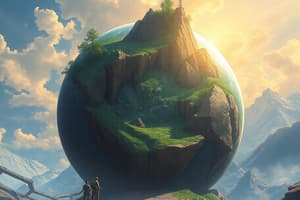Podcast
Questions and Answers
What is the primary cause of global warming?
What is the primary cause of global warming?
- Plate tectonics
- Increase in greenhouse gases (correct)
- Weathering and erosion
- Sea-floor spreading
What is the result of the breakdown of rocks into sediments?
What is the result of the breakdown of rocks into sediments?
- Formation of volcanoes
- Creation of new oceanic crust
- Transportation and deposition of sediments (correct)
- Creation of mountains
What is the process of new oceanic crust being created at mid-ocean ridges?
What is the process of new oceanic crust being created at mid-ocean ridges?
- Plate tectonics
- Glacier formation
- Sea-floor spreading (correct)
- Weathering and erosion
What is the consequence of rising global temperatures?
What is the consequence of rising global temperatures?
What is the result of habitat destruction?
What is the result of habitat destruction?
What is the term for the decline or extinction of species?
What is the term for the decline or extinction of species?
What is the primary contributor to climate change and ecosystem degradation?
What is the primary contributor to climate change and ecosystem degradation?
What is the need to adopt environmentally conscious practices and policies?
What is the need to adopt environmentally conscious practices and policies?
What is the characteristic of the Earth's systems?
What is the characteristic of the Earth's systems?
What is the process that results in the creation of mountains, volcanoes, and earthquakes?
What is the process that results in the creation of mountains, volcanoes, and earthquakes?
Flashcards are hidden until you start studying
Study Notes
Introduction to Changing Earth
- The Earth is a dynamic planet, constantly undergoing changes in its geology, climate, and ecosystems.
- These changes occur on various timescales, from sudden events to gradual processes that span millions of years.
Geologic Changes
- Plate Tectonics: The movement of the Earth's lithosphere, resulting in the creation of mountains, volcanoes, and earthquakes.
- Weathering and Erosion: The breakdown of rocks into sediments, which are then transported and deposited in new locations.
- Sea-Floor Spreading: The process of new oceanic crust being created at mid-ocean ridges, pushing older crust apart.
Climate Change
- Greenhouse Gases: Atmospheric gases, such as CO2 and methane, that trap heat and contribute to global warming.
- Global Temperature Increase: The average global temperature has risen by about 1°C since the late 1800s, with more rapid warming in recent decades.
- Consequences: Rising sea levels, melting glaciers, and altered ecosystems and weather patterns.
Ecosystem Changes
- Biodiversity Loss: The decline or extinction of species, resulting in reduced ecosystem resilience and function.
- Habitat Destruction: The destruction or degradation of natural habitats, such as forests, coral reefs, and wetlands.
- Invasive Species: Non-native species that outcompete native species for resources, altering ecosystem dynamics.
Human Impact on the Changing Earth
- Anthropogenic Activities: Human activities, such as deforestation, pollution, and overfishing, contribute to climate change and ecosystem degradation.
- Sustainability: The need to adopt environmentally conscious practices and policies to mitigate the impacts of human activities on the Earth's systems.
Conclusion
- The Earth is a dynamic and interconnected system, with changes in one component affecting others.
- Understanding the causes and consequences of these changes is crucial for developing strategies to mitigate their impacts and promote a sustainable future.
Geologic Changes
- The Earth's lithosphere is in constant motion, resulting in the creation of mountains, volcanoes, and earthquakes due to plate tectonics.
- Weathering and erosion break down rocks into sediments, which are then transported and deposited in new locations.
- Sea-floor spreading creates new oceanic crust at mid-ocean ridges, pushing older crust apart.
Climate Change
- Greenhouse gases, such as CO2 and methane, trap heat and contribute to global warming.
- The average global temperature has risen by about 1°C since the late 1800s, with more rapid warming in recent decades.
- Consequences of climate change include rising sea levels, melting glaciers, and altered ecosystems and weather patterns.
Ecosystem Changes
- Biodiversity loss is the decline or extinction of species, resulting in reduced ecosystem resilience and function.
- Habitat destruction, such as deforestation, destroys or degrades natural habitats, reducing biodiversity.
- Invasive species outcompete native species for resources, altering ecosystem dynamics.
Human Impact on the Changing Earth
- Anthropogenic activities, such as deforestation, pollution, and overfishing, contribute to climate change and ecosystem degradation.
- Sustainability requires adopting environmentally conscious practices and policies to mitigate the impacts of human activities on the Earth's systems.
Conclusion
- The Earth's systems are interconnected, and changes in one component affect others.
- Understanding the causes and consequences of these changes is crucial for developing strategies to mitigate their impacts and promote a sustainable future.
Studying That Suits You
Use AI to generate personalized quizzes and flashcards to suit your learning preferences.




